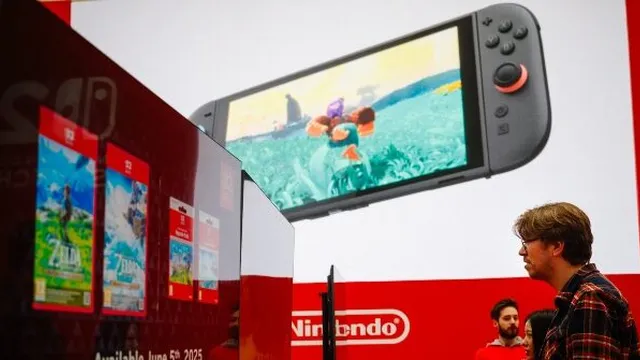
Nintendo's Bowser denies tariffs impacted Switch 2 pricing
2025-04-09 16:17- Nintendo announced the Switch 2 will launch at $450 in the U.S., increasing from $300.
- Critics blamed Trump's tariffs for the higher price, but Nintendo clarified that tariffs were not a factor in pricing.
- Despite enhancements, many gamers feel the price increase is unjustified, considering the planned $10 charge for the Welcome Tour.
Express your sentiment!
Insights
In early April 2025, Nintendo announced the price of its highly anticipated Switch 2 console would be set at $450 in the United States, a considerable increase from the original Switch's $300 launch price. This price hike drew significant backlash from gamers, with many attributing the cause to Donald Trump's tariffs on imported goods, particularly since the majority of gaming consoles are manufactured in countries like China and Vietnam, both of which faced high tariffs imposed by the Trump administration. Market analysts initially speculated that the pricing of the new console might be influenced by the tariffs, with some even labeling the $50 increase as a 'Trump tax.' Joost van Dreunen, an industry expert, highlighted how heightened tariffs could impact the pricing of video game consoles. However, Doug Bowser, President of Nintendo of America, clarified that the price of the Switch 2 had already been determined before the tariffs were enacted, indicating that the increase was primarily due to the console's improved features and technology. The new Switch 2 includes significant hardware upgrades, such as a larger LCD screen with variable refresh rate capabilities, a custom-built CPU/GPU from Nvidia, and greater internal storage. Nvidia has also reported that the Switch 2 will deliver up to ten times the graphics performance of its predecessor, supporting high-end features like DLSS and ray tracing. Despite these advancements, many gamers questioned whether these improvements justified the steep price increase, especially in light of anticipated higher prices for Switch 2 games, which are expected to range between $70 and $80. Additionally, Nintendo intends to charge $10 for a 'Welcome Tour' that will teach users how to operate the new device. Amidst this controversy, Nintendo paused preorders for the Switch 2 in the U.S. and Canada to evaluate the potential impact of tariffs and shifts in market conditions. While the launch date was confirmed for June 5, 2025, there was growing speculation whether the retail price might increase further in the future. Analyst David Cole from DFC Intelligence stated that although he expected the console to launch at the initial $450 price point, the overall cost might increase by up to 20% in the next two years due to economic pressures and production costs. As of now, Nintendo is continuing to sell the original Switch models alongside the Switch 2, potentially creating a complex pricing scenario as consumers weigh their options between the existing console and the new, more advanced model. Overall, the situation surrounding the Switch 2 pricing reflects broader economic challenges influenced by international trade policies and asks important questions about the future of gaming console costs in light of ongoing tariffs and market conditions.
Contexts
The history of Nintendo's console pricing strategy reflects a strategic blend of market analysis, consumer behavior understanding, and innovative pricing techniques that have evolved over the decades. Since its inception, Nintendo has consistently positioned itself as a leader within the gaming industry, utilizing its pricing strategy not only to maximize profitability but also to maintain competitive advantage. The company's initial foray into the console market began with the Nintendo Entertainment System (NES) in 1985, which launched at a price point designed to attract a broad demographic while simultaneously undercutting competitors. This initial pricing strategy laid the groundwork for Nintendo's approach to future consoles, emphasizing affordability without sacrificing quality, thereby building lasting brand loyalty among consumers. As technology progressed, so did the complexity of Nintendo's pricing strategy, particularly with the advent of the Super Nintendo Entertainment System (SNES) in 1991 and the Nintendo 64 in 1996. The pricing during these eras reflected not only the added value of enhanced graphics and gameplay experiences but also a careful consideration of supply chain costs and competitive pricing pressures. Nintendo maintained a premium pricing model, aiming to convey a sense of higher value amid increasing competition from other platforms, such as Sony's PlayStation. This strategy was supported by a robust roster of exclusive titles that justified the pricing and reinforced consumer preferences for Nintendo's platforms. Entering the 2000s, Nintendo's pricing strategy underwent another transformation with the introduction of the Wii in 2006, which was characterized by its disruptive pricing model aimed at reaching non-traditional gaming audiences. Priced significantly lower than competitors like the Xbox 360 and PlayStation 3, the Wii's strategic pricing attracted a vast array of consumers, from casual players to families, effectively expanding Nintendo’s market share. This dramatic shift illustrated Nintendo's recognition of changing consumer trends and preferences within the gaming landscape, employing a value-centric pricing approach that emphasized accessibility and unique gameplay experiences as key drivers of consumer engagement. In recent years, Nintendo continued to innovate its pricing strategy through the launch of the Nintendo Switch in 2017, which notably combined elements of both home and portable gaming. The Switch's price point effectively positioned the console in response to evolving consumer habits favoring versatility and convenience. Moreover, Nintendo's pricing strategy appeared to be increasingly influenced by digital content sales, subscription services, and innovative promotional offerings that kept consumers engaged while ensuring sustained revenue streams. Nintendo’s adeptness at integrating traditional console pricing with contemporary digital trends has not only ensured its ongoing success but also positioned it as a study subject in effective pricing strategies within technology and entertainment.